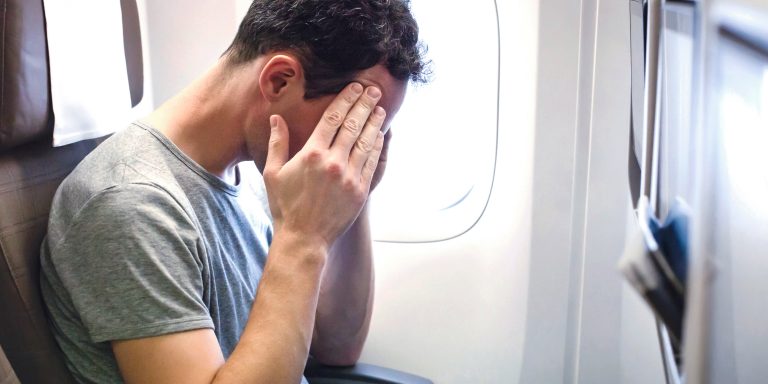
Motion sickness: symptoms and remedies
What are the signs of motion sickness, such as airsickness or seasickness? What medications help treat the symptoms? Are there any household remedies for motion sickness? Find out how to prevent and treat kinetosis.
What is motion sickness?
Motion sickness, or kinetosis, is a common reaction to being in motion. Symptoms often occur during winding drives, bumpy flights or journeys by sea. What causes it? When you’re travelling by car, say, your body is motionless. Your nerves and receptors can tell that your muscles aren’t moving. Your eyes, however, register rapid movements. The balance-regulating organ in your inner ear also gathers information – about corners, acceleration and slopes. This means that your eyes, inner ear and body are sending conflicting signals to your brain, which is unable to reconcile the differing perceptions of motion and acceleration. Your brain is overloaded and your nervous system is overstimulated, causing you to experience motion sickness in the form of symptoms such as dizziness and nausea. Motion sickness can be exacerbated by your mental state. You often suffer more if you feel anxious or stressed before you even set off.
There are various different types of motion sickness:
- Seasickness: this occurs when travelling by boat or some other kind of waterborne vessel.
- Carsickness: this form of motion sickness occurs when travelling by car.
- Airsickness: travelling in an aircraft can trigger this form of motion sickness. A fear of flying generally makes the symptoms of airsickness worse.
- Land sickness: in this case, you suffer from the symptoms of motion sickness once you are back on dry land following a journey by boat.
Motion sickness: what are the symptoms?
The most frequent signs of motion sickness are:
- Vomiting: if you suffer from motion sickness, vomiting is one of the possible symptoms. The brain reacts to the contradictory signals it is receiving by releasing histamine, among other things. Histamine is a neurotransmitter that interacts with the part of your brain that regulates nausea. This can lead to nausea when flying, travelling by boat or driving.
- Sweating: travel sickness can cause sufferers to sweat more (often cold sweat) or break into a sweat.
- Dizziness: for those who suffer from motion sickness, dizziness can also result from the contradictory signals the brain receives from the body.
- Headaches: travel sickness often causes headaches.
- Fatigue: motion sickness is often accompanied by fatigue. In cases of severe kinetosis, this can even lead to apathy (listlessness, indifference).
Motion sickness initially causes mild symptoms, but these can get more severe as time goes on. Additional symptoms may also develop, such as a sudden drop in blood pressure, tachycardia, a subjective feeling of being very ill or hyperventilation (breathing more rapidly or taking deeper breaths).
The symptoms of motion sickness are usually clear. They always occur in the same situations, such as in a car or on a boat. That’s why, in mild or moderate cases, those affected don’t usually consult a medical professional. If the symptoms are more severe, however, it makes sense to seek medical attention. The doctor will check whether you really are suffering from motion sickness or if it could be an infection or food poisoning.
What remedies are there for travel sickness?
There are some preventive measures that you can take to relieve or even prevent the symptoms of motion sickness. As a general rule, you can reduce your risk of developing symptoms by eating the right diet. But what should you eat to help with travel sickness? Try to eat lighter, less fatty foods. Avoid alcohol and cigarettes. And chew a piece of gum to stop your stomach from overreacting.
Preventing motion sickness on the road
Feelings of nausea are common when travelling by car. What can you do to prevent this? Ideally, you should drive yourself. If you are a passenger, you should sit in the front seat. The driver should try to avoid changing lanes abruptly or accelerating rapidly. Don’t read when the car is moving, open the window every now and then, and stop to stretch your legs every two hours – particularly on long journeys. Focus your gaze on a fixed point on the horizon.
When travelling by bus, try to sit in the middle or at the front, where the swaying of the vehicle is less pronounced. On trains, you should ideally sit facing the direction of travel and stand up regularly to stretch your legs. And, whether you’re travelling by bus or by train, focus your gaze on a fixed point on the horizon.
No matter if you’re travelling by car, bus or train, keep your head and body as still as possible, and lean back, facing forwards. Make sure you’ve slept well before embarking on a journey. You should also try to stay relaxed. If you’re constantly on the lookout for the first signs of motion sickness, they’re sure to come along soon.
Preventing airsickness
What can you do to prevent travel sickness on planes? The best place to sit when flying is in an aisle seat or near the wing, because this is where you will feel the movement of the plane the least. Alternatively, you can sit towards the front of the plane. On longer flights, it makes sense to try to get some sleep.
Preventing seasickness
How can you prevent seasickness? If you’re travelling by sea, you should ideally choose a cabin or seat in the centre of the vessel – either right above the waterline or on deck. This way, you’ll prevent or relieve feelings of nausea due to seasickness. You should also move with the motion of the ship rather than counter to it.
What can you do about travel sickness?
There are lots of different remedies for motion sickness, including a range of medications as well as tried-and-tested household remedies. Read on to learn about the best remedies for seasickness, carsickness and airsickness.
Travel sickness: what medications help?
There are tablets and suppositories available to treat motion sickness, as well as chewing gum and plasters. You can generally obtain these from a pharmacy without a prescription. In severe cases, your doctor will prescribe the appropriate medications. Most medications that are available in Switzerland for the treatment of motion sickness contain the following active ingredients:
- Meclizine: this antihistamine is available in combination with caffeine and pyridoxine. Thanks to the caffeine, these travel sickness medications take effect without causing drowsiness. They are effective for 12 to 24 hours.
- Dimenhydrinate: dimenhydrinate is used to treat motion sickness and can often be found in the form of chewing gum. These kinetosis medications are effective for about 1 to 3 hours.
- Dimetindene maleate: this active ingredient of some motion sickness medications is an antihistamine.
Talk to a pharmacist or doctor about the right dosage. You should also discuss which travel sickness tablets or other remedies are best for you. You should take your medication at the first signs of motion sickness. If you already know that you tend to get motion sickness, you should take your anti-motion-sickness medication half an hour to an hour before setting off, depending on the medication in question.
It’s worth noting that you never know what’s going to happen when you’re on holiday. So in addition to travel sickness tablets, you should also pack medications for diarrhoea and pain when travelling.
Household remedies for travel sickness
In addition to medication, there are also other remedies for travel sickness, a lot of which can be found around the home.
- Ginger can help with travel sickness because it reduces nausea and dizziness. You can either chew on fresh ginger slices or consume it as a powder. Ginger is also available in the form of tablets, for example to treat seasickness.
- Tea containing aniseed, fennel or chamomile is also good at combatting travel sickness.
- Pleasant aromas such as citrus or peppermint help you feel better when you’re suffering from motion sickness. You can use this remedy by putting a small amount of essential oil on a cloth or cotton pad and taking a sniff whenever you feel the need.
Acupressure also helps against travel sickness. For example, you can get travel sickness bracelets that have small nubs on the inside. These apply pressure to what’s known as the Nei Kuan point on the wrist, which in some cases can alleviate feelings of nausea.
Children often suffer from motion sickness between the ages of 2 and 12. There are a number of different remedies that help with travel sickness in children:
- Chewing gum alleviates travel sickness in children aged 6 and above. The doses are also usually low.
- If your child suffers from travel sickness, plant-based remedies are a good choice. These include products containing ginger to treat seasickness or other forms of travel sickness.
- Medications containing the active ingredients meclizine, pyridoxine and caffeine are also suitable for treating motion sickness in children, but only from the age of 12.
Please note that, although there are a lot of medications that help with travel sickness in children, you should always consult a paediatrician before giving your child medication such as chewing gum to help with travel sickness. These remedies can sometimes have the opposite effect on small children in particular, leading to vomiting and nausea.
Homeopathy to treat motion sickness
There are a number of different homeopathic remedies for treating motion sickness, one of which is Cocculus D6. You can get Cocculus D6 in the form of drops, globules or travel sickness tablets. Talk to your doctor about what homeopathic remedies are suitable for you, for example to treat seasickness.
Other remedies for travel sickness
What else can you do in the event of seasickness or other forms of travel sickness?
- You can get glasses to help counter travel sickness. These contain a liquid that creates an artificial horizon in order to avoid contradictory sensory perceptions.
- Neck pillows are also handy when you’re travelling. These keep your head in a steady position, potentially preventing travel sickness.
- Fresh air helps when you’re suffering from motion sickness. Open the windows in your car, for example.
Motion sickness affects a lot of people and tarnishes their enjoyment of travelling. By preparing properly and taking the right measures, however, you can alleviate the symptoms. Try different strategies and find out what works best for you. Speak to your doctor or a pharmacist if necessary.

The specialist provided the editorial team with advice and input for this article. Sonja Signer (qualified nurse) works for the Helsana health consultation service. She helps customers on issues to do with prevention and health promotion.

Newsletter
Find out more about current health issues every month and get all the information you need about our attractive offers from all Helsana Group companies * delivered by e-mail to read whenever it suits you. Our newsletter is free of charge and you can sign up here:
We did not receive your information. Please try again later.
* The Helsana Group comprises Helsana Insurance Company Ltd, Helsana Supplementary Insurances Ltd and Helsana Accidents Ltd.